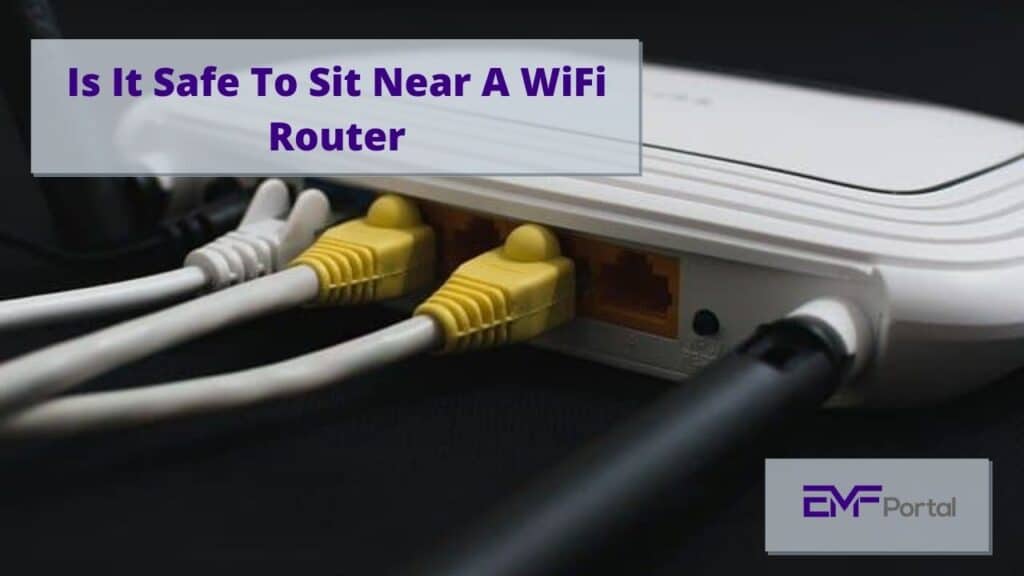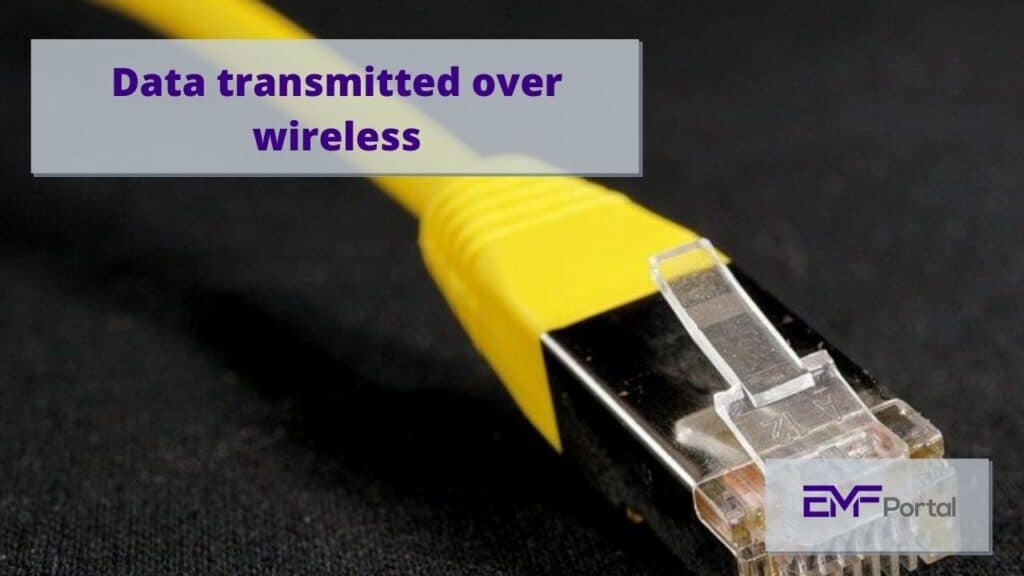
Is It Safe To Sit Near A WiFi Router? I have spent many hours of research to give you the best answer in this article.
The quick answer is:
A WiFi router emits high EMF radiation, sit far away as possible, at least 10 feet away from your body.
Electromagnetic radiation has been shown to have detrimental effects on the bodies and minds of those who are continually exposed to it.
If you are concerned about the ill effects of it all, it is understandable. After all, it can cause a plethora of issues and disorders ranging from headaches and migraines to diabetes and maybe even cancer. We have a bunch of articles on this website that are dedicated to understanding electromagnetic radiation and protecting against it, should you be interested.
In this article, however, we would be focusing solely on Wi-Fi.
If you’ve been living under a rock for the last decade, Wi-Fi is the technology that enables us to connect to the internet wirelessly from our smart devices. Be it our laptops or smartphones, we only have to connect to the network by signing in with our right password, and voila!
We have the internet. There are several very attractive bonuses to using a wireless internet connection, a testament to its popularity in today’s world. The main positives include a lack of wires (that keeps a clean look to your home) and house-wide connectivity.
However, the downsides to wireless internet might just outweigh its colossal pluses, the primary of which is radiation. We’ve discussed this in detail on this website but if you are just beginning to get into this world of electromagnetic radiation, it is important to know and understand that all electronic circuits emit electromagnetic waves at some level.
Most of them are harmless since they can’t travel far enough from the board and are generally weak in strength. However, there are many that transmit electromagnetic waves as a means of signal to communicate. And routers fall in the latter category. Wireless routers are built to enable us to access the internet without the hassle of dealing with cumbersome wires.
But have you wondered how they actually achieve this feat? The lack of wires is compensated for by having the router blast off electromagnetic waves that are then received by your smart devices.
Data is encoded in those waves which then get decoded in the receiving end and you have internet. This is a very sophisticated process involving a lot of components that ultimately end up polluting your home environment. To understand this even better, let’s take a look at how Wi-Fi lets you surf the internet in detail.
How data is transmitted over wireless

Traditionally, data transfer has always been done by wires. However, it all changed in the late 2000s with the introduction of wireless technology.
However, the underlying science behind it is quite sophisticated. To help data travel through the air, we use a router which is basically a digital encoder and transmitter. Data is fed to the router through wires which then encodes in a high-frequency electromagnetic pulse and blasts off several thousand times every second.
Our smart devices, be it smartphones or laptops, are equipped with receivers that receive the encoded EMF signal and then decode it. When we want to send something from our phone, the scenario just flips. Our phones transmit the data and the router picks it up.
As it is perhaps obvious from this explanation, this happens a few thousand times every minute. EMF waves die out with distance which is why if you go too far away from your router, you start losing connection strength.
However, they are high-frequency waves and thus can easily penetrate physical obstructions such as walls. What this illustrates is that the room where your router is placed is an absolute mess in terms of radiation.
Since the router transmits these waves thousands of times a minute, they don’t get the time to naturally dissipate and thus build up in the enclosed space. If someone is exposed to that high level of radiation every day, it can cause serious complications to their health.
What are the most common symptoms of radiation exposure?
All of us get exposed to radiation at some level during the day but continuous exposure to a very high degree of radiation can be a source of serious medical mishaps. People end up exposing themselves continuously for various reasons – from a job that requires them to be on the computer for extended periods of time to just binge-watching something on Netflix.
If you feel you too are overexposed, look out for these short term symptoms:
- Headaches.
- Mood swings.
- Lack of focus.
- Loss of appetite.
- Mild to serious insomnia.
- Emotional imbalance.
If you can relate to any of these, you might be overexposing.
Is it safe to sit near my router? – I wouldn’t advise it.
The reason is plain and simple: your router is designed to do two very specific things – transmitting EMF radiation and receiving them.
Therefore it is natural that the immediate environment near the router would be a cesspool of radiation. If you choose to sit near that area, you risk exposing yourself to all that radiation, none of which is desirable.
I would strongly suggest that you keep your router isolated and never be in the same room for more than 10 minutes at a time but if you absolutely cannot change the location of your router, it is a good idea to introduce some distance between you and the router.
If you must sit in the same room, make sure that the router is at least 10 feet away from your body.
You’d still get bombarded with radiation but it wouldn’t be nearly as intensive as sitting right next to it.
What precautions can I take to safeguard myself aganst a wifi router?
The best idea would be to chuck wireless and go old school with your internet connectivity. You can find out how to do this here. However, if that is not possible, we still have some tips for you that you can follow to curb your radiation exposure.
We are looking at my three top tips here but if you are interested, please check out my other articles which are packed with detailed analysis of wireless communication and more tips on how to reduce radiation.
Recommended products to use
- EMF Protection & Anti-Radiation Blanket
- Laptop heat shield
- Cell Phone EMF Protection
- Tablet + iPad EMF Radiation Protection Case
- Blue Light Blocking Glasses & Computer Glasses
Turn it off when not in use
You don’t use the internet all the time (like when you’re cooking or bathing) so it’s a good idea to just turn off the Wi-Fi router when you’re not using it. It saves you money on utility bills but more importantly, it doesn’t pollute your home with unnecessary radiation.
This is especially effective if you turn it off while going to bed. This also allows the radiation to dissipate naturally so that the next day you wake up to a fresh house void of any EMF radiation.
Keep your smart devices out of your bedroom
Our bodies can handle EMF radiation as long as it can get time to heal themselves. Constant radiation exposure doesn’t allow our bodies to heal and thus the negative effects of it on us compounds over time.
To break that cycle, start off by making your bedroom an EMF-free zone.
Don’t allow any smart devices in the room and swap out all electronic appliances like alarm clocks with battery-operated counterparts. This allows our body to heal at night from the damage our cells and tissues have endured throughout the day. This reduces your overall health risk and betters your chances of not getting overexposed.
Add distance
With radiation, always remember that distance is your friend. Try to spend most of your time in rooms where you don’t have your router so that you can avoid the direct onslaught of radiation. However, if you must, try and be a least 10 feet away from the router at all times to allow for minimal possible exposure within the room.
Related questions
Is it scientifically proven that Wi-Fi can cause harm to us?
We have enough data to theoretically derive the consequences of EMF overexposure, and the scientific community is unanimous in claiming that they may have severe effects on human health over the long term including fostering chronic diseases such as diabetes and cancer.
However, we do not have enough practical data to corroborate those claims. The main problem is that EMF radiation is a relatively recent phenomenon and the study into the effects of it needs to be long-term, which isn’t possible yet.
However, just because we don’t have the case study data doesn’t mean there’s not a real risk of health here and that we shouldn’t be worried. After all, prevention is better than cure.


